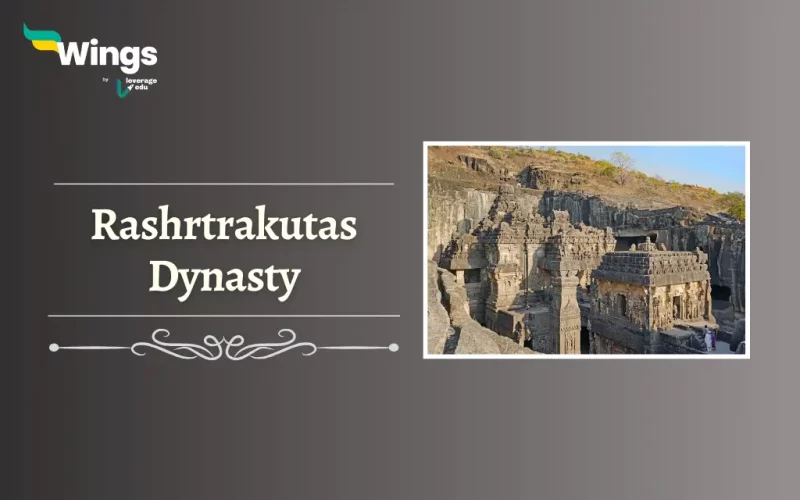The Rashtrakutas were a powerful dynasty in the Deccan region of Medieval India. They also called themselves the Satyaki and ruled a massive kingdom between 755 to 975 CE. Their kingdom was vast and covered areas from Malwa in the west to Kanchi in the south. The rulers paid special emphasis to art and architecture. Rashtrakutas have developed the Kailasnatha Temple and the Elephanta Caves. In this blog, we will discuss the origin, important rulers, administration, society and decline of the Rashtrakutas.

Also Read: Pallava Dynasty: Origin, Achievements, and Legacy
Origin of Rashtrakutas
Table of Contents [show]
The origin of Rashtrakutas is a debatable topic among historians. Moreover, it is also difficult to explain the relationship between Rashtrakutas who ruled in the 6th century and those in the 8th to 10th century. There are not only mixed opinions but also mixed evidence about their origin.
Having originated as agrarians the Rashtrakutas claim to be the descendants of Yadavas. Some historians even believe that Maharashtra got its name from this epic clan. Their lineage might be disputed but the one thing clear about their origin is that they defeated the Chalukyas to establish their rule in the kingdom.
Also Read: Chauhan Dynasty: Origin, Rulers & Decline
Important Rashtrakutas Rulers
Here are some of the most important Rashtrakuta rulers to have emerged during the time.
- Krishna I (756-774): He was the uncle of the last emperor who died without an heir to the throne. He ended the Chalukya rule and also defeated the Gangas and Konkans. He also built the Kailasa temple of Ellora.
- Dhruva Dharavarsha (780-793): He succeeded his father Govinda II and established the golden age of the Rashtrakutas. He defeated the ruler of Kannauj, Gurjara-Pratihara Kingdom and Pala kingdom. This was the time of tripartite wars between the Kannauj rulers, Gurjara Pratiharas and the Rashtrakutas.
- Govinda III (793-814): He was the most powerful ruler of the dynasty. He expanded the kingdom from Bengal to Banaras and from Kannaj to Cape Comorin. He ended the tripartite wars by defeating the kings.
- Amoghavarsha I (814-878): He established a new capital Manyakheta in Karnataka. He converted to Jainism and had a great interest in education and literature. An Arab merchant Suleiman declared Amoghvarsh I one of the greatest four rulers of that time.

Administration & Society
Here is a list of some very important points about the administration of the Rashtrakutas;
- King was the head of the government.
- Rulers were chosen with heredity.
- The provinces under the kingdom were ruled by Rashtrapatis.
- There was a federal system of government and the districts were overseen by Vishayapati.
- Every district also had their Nadugowda for administration.
- Villages were overseen by Grampatis.

Decline of Rashtrakutas
In 972 CE the Rashtrakuta ruler Khottiga Amoghavarsha was defeated and killed by a ruler from Parmara Dynasty. The capital was destroyed during this and was in shackles. The last ruler of the dynasty was Indra IV who committed suicide in 982 CE by fasting himself to death according to a Jaina ritual.
Thus, this brought about the end of a powerful kingdom. However, the architecture and administrative influence of the Rashtrakutas were adapted by the later rulers.
Relevant Blogs
| Sunga Dynasty | Hoysala Dynasty |
| Yadava Dynasty | Kushan Dynasty |
| Satavahana Dynasty | Kakatiya Dynasty |
| Slave Dynasty | Tughlaq Dynasty |
| Gurjara-Pratihara Dynasty | Haryanka Dynasty |
This was all about the Rashtrakutas Dynasty. For more informative blogs on Indian History stay tuned to our General Knowledge section.
 One app for all your study abroad needs
One app for all your study abroad needs















 45,000+ students trusted us with their dreams. Take the first step today!
45,000+ students trusted us with their dreams. Take the first step today!
